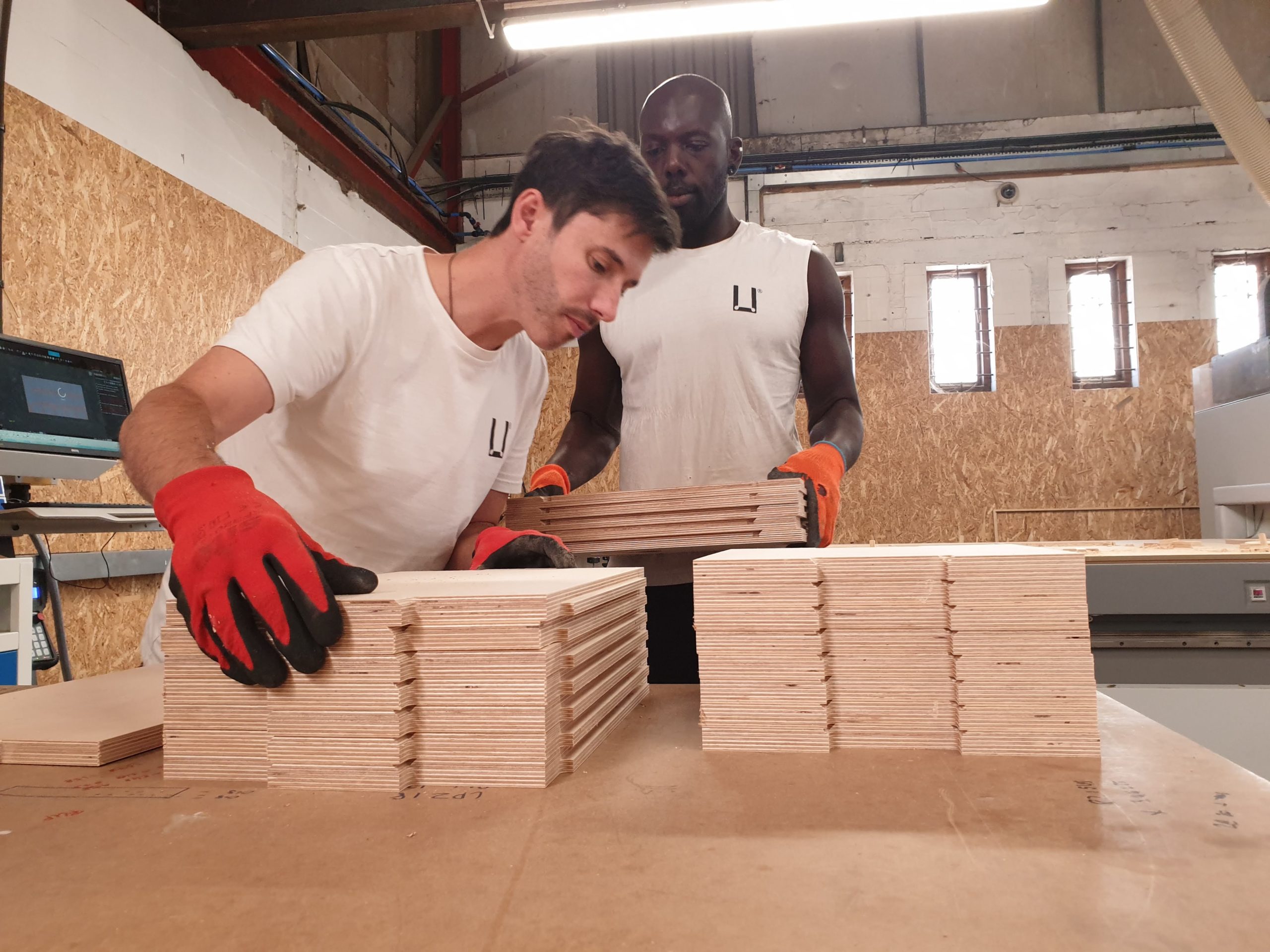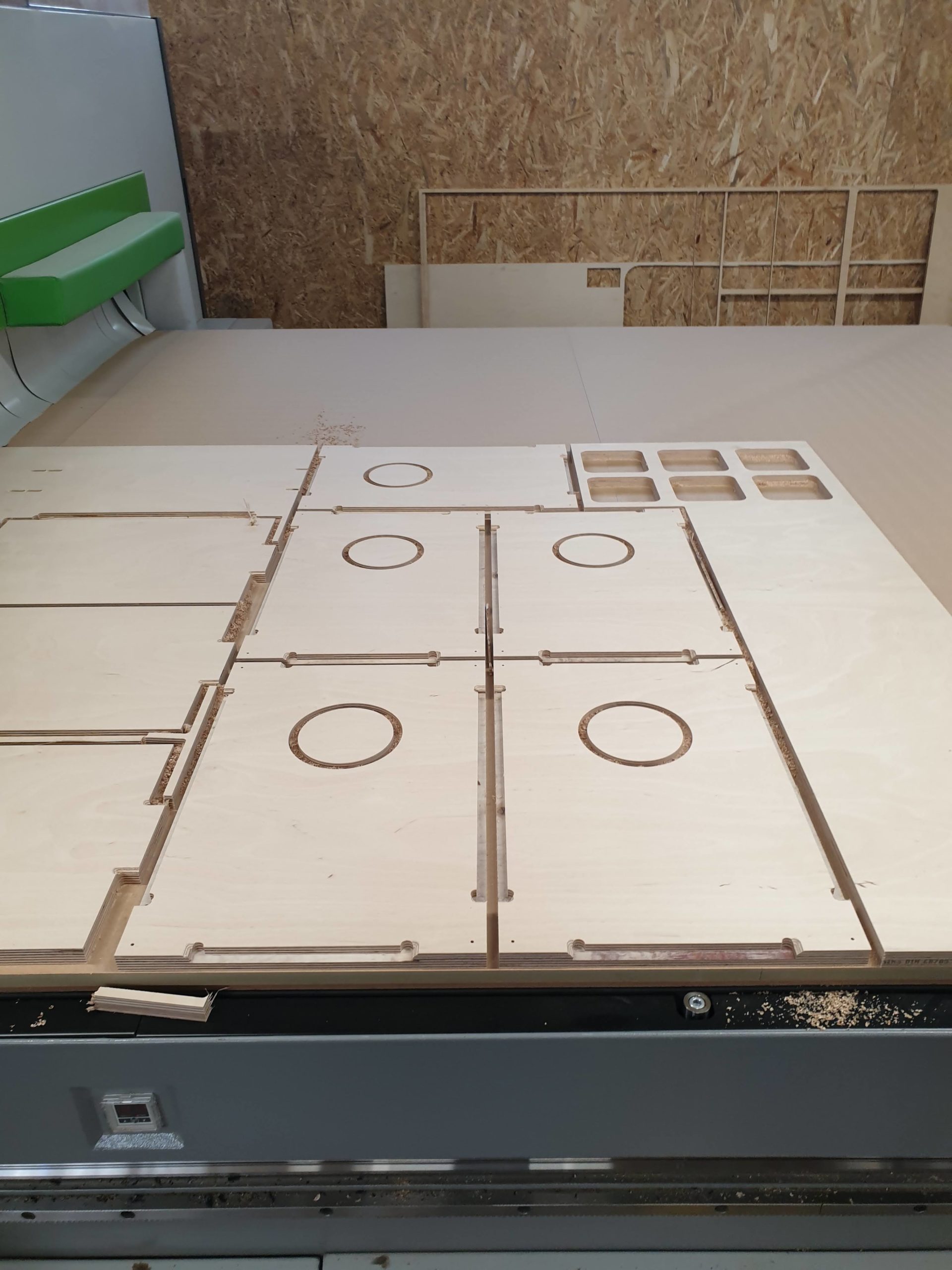
U-Build & CNC Machines make the perfect fit
We’ve put together a list that includes engraving bits, up-cutters, and chamfer bits. The exact terminology used to describe each router bit may differ from country to county. We’ve gone with the terms we use in our London-based studio to avoid any confusion. Whether you’re an experienced maker looking to do a U-Build or a hobby maker exploring CNC milling in your local maker space, this guide will help you learn the ropes.
CNC machines
Essentially large computer-controlled drills – use many types of ‘router bits’ to cut material in different ways. We couldn’t possibly run through them all, so we’ve boiled it down to the seven key router bits that are regularly used by CNC workshops to manufacture the U-Build System.
Down-cutter
Generally used for a first pass, this bit forces material down so as to create a clean cut on the top surface of the material. Notice the spiral flutes running downwards. If the bit goes through the material, there is a danger it will force the grain to split and rip out on the opposite side. A good extraction system is crucial here, as this stops the build-up of dust from this type of cutter.
Up-cutter
Opposite to the down-cutter, this tool’s flutes rotate in the opposite direction, forcing chips and debris up away from the main material. If this cutter is used for the first pass the top surface may rip out, causing unpleasant splintering around the cut area. The tool is best used after a down cutter to cut through the remaining material, eliminating tear out on the opposite face. Ideally used on machines with a vacuum bed, this cutter allows a very good surface finish when used in combination with a down-cutter.
Compression cutter
Possibly the most common router bit used to manufacture CNC plywood products. This tool combines the down-cutter and up-cutter into a single router bit. The bottom of the bit features up-cutting flutes with the rest of the bit featuring down-cutting flutes. The bottom section of the tool spirals upwards with the section above rotates material downwards. This tool can cut many materials in one pass with the opposing flute direction preventing chipping or fuzzing on the top and bottom of the cut. Because the saw dust is compressed at the bottom of the cut, components are packed in place tightly meaning they do not move on the machine bed, as air pressure isn’t lost due to the seal not being broken.
Skimming/Rebate bits
These tools are great for skimming off a thin layer of material over large surface areas. Thanks to their large diameter they are able to cut very quickly. These bits are used to remove laminates from components that need to be glued together. Typically, they only cut to a depth of between 1 mm/ 2 mm in order to leave the bare wood beneath the laminate untouched. They are not really used with the U-Build system so much, however are used to flat and smooth off the spoil board which the plywood sits upon whilst being cut. The flatter the surface the stronger the pull or grip from the vacuum bed of the machine.
45 degree chamfer bit
A chamfer bit or ‘V bit” is commonly used to create an angled edge. On the U-Build system, the tool is used to give window frames an angled finish. They can also be used to reduce the sharpness of laminates and brittle materials by softening the edges. Chamfer bits are available in many angles with the most common being 45 degrees.
Fillet bit
A fillet bit or ‘rounding bit’ can also be used to give all edges a smooth rounded finish. The size of this rounded edge can be controlled by the depth of the pass or the size of the radius. Deeper passes will result in larger rounds. Shallow passes will result in small rounds. Different shapes of round overs can be achieved with different fillet bits.
1mm engraving bit
These small bits are very fragile and can only cut into material 1-2 mm at a time. The bit must pass through the material very slowly to avoid it snapping. Available as an up-cutter or down-cutter, this bit is perfect for detailing. They can be used to add logos and other artwork, sometimes just to label parts for assembly.
The U-Build system is designed to be made using CNC routers. As mentioned above CNC routers are essentially large computer-controlled drills, or milling machines, which can cut shapes from sheet materials – usually wood, but also plastic and soft metals.
CNC stands for computer numerical control, which refers to the tool following a path that has been programmed into a computer. These paths (lines or vectors) are drawn in CAD software by a designer, architect or engineer and then converted to tool paths that tell the CNC machine how to interpret each line. The machine needs to know whether it should cut right through the material, or only cut to a certain depth. It also needs to know where the tool should run on – inside the line, on the line or outside the line.
U-Build cutting files are designed to use 3-axis CNC machines, which are the most prevalent type. Imagine you are looking down on a sheet material; the X-axis is running left to right, the Y-axis top to bottom, and the Z-axis is plunging in and out of the material in the direction of your view.
To help explain different types of cut, we’ve put together a guide covering some of the most common cuts that are performed on a CNC machine when processing wooden sheet materials.
Cut-outside-line
Tool cuts through the material, running along the outside of a closed line in a manufacturing document/ blueprint.
Cut-inside-line
Tool cuts through the material, running along the inside of a closed line.
Chamfer-online
Chamfer tool cuts to desired depth and runs along an open or closed line, leaving an angled edge
Engrave-online
Tool of smaller diameter cuts to shallow depth and follows open or closed lines.
Fillet-online
Fillet tool cuts to desired depth and runs along an open or closed line, leaving a rounded edge.
Hole
Tool finds the centre of the circle and drills to desired depth at required diameter.
Pocket-inside-line
The tool pockets the material to a required depth, milling the area inside a closed line.
Pocket-outside-line
The tool pockets to a required depth, milling area outside a closed line.
Dog-bones
Tools used on CNC machines are round and spin axially, meaning it is not possible to cut sharp inside corners. Instead, the tool must leave semi-circles on inside edges matching its diameter. This allows for cut parts to butt up flush with each other when desired. For U-Build boxes this is crucial in order to make the system airtight.

Nesting
‘Nesting’ is the laying out of parts on a sheet for cutting. Material efficiency is a top consideration for any environmentally mindful practice. An essential part of the U-Build system is the principle of minimising waste. It’s important to design and engineer with the material dimensions from which you will be cutting in mind. Failure to do this can result in inefficient designs which are extremely wasteful.
Fortunately, there are other companies that align with our values that make the process seamless. As an example, the insulation we recommend is standardised to the internal width of our boxes, making the process of installing a satisfactory joy.
We aim to make each U-Build a pleasure to put together. This starts with the fundamentals at the beginning of the process – making sure the material is sourced and used responsibly and efficiently.
Glossary
CNC – computer numerical control
CAD – computer-aided design